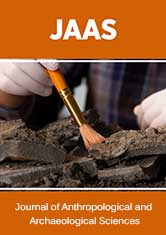
Lupine Publishers Group
Lupine Publishers
Menu
ISSN: 2690-5752
Opinion(ISSN: 2690-5752) 
Some Orientations in the Latin American Narrative of the XXI Century Volume 3 - Issue 4
Ricardo Ferrada Alarcón*
- Profesor de Literatura, Escuela de Castellano, Universidad Católica Silva Henríquez, Santiago de Chile, Chile
Received: February 01, 2021 Published: February 10, 2021
Corresponding author:Ricardo Ferrada Alarcón, Escuela de Castellano, Universidad Católica Silva Henríquez, Santiago de Chile, Chile
DOI: 10.32474/JAAS.2021.03.000168
Opinion
First of all, in a general statement we can say that in a significant part of the Latin American novel at the initial decades in the XXI century, in the plot of the narrated world a context of cultural transformations becomes evident to the reader.
Faced with the question how this textual world is configured, elucidating it leads not only to the reflection on language variables, but also to the narratives constructions and strategic devices that we read as representations or approximations of the experience of the world, that makes the temporality evoked in the fiction more understandable: we read imagined actions that are positioned in contrast with the present. What is narrated raises questions -as the writers say- rather than the delivery of answers; they also point out that the narrative in no case constitutes a reality quote from the real world, even if it looks like similar when it’s named.
Whatever its modality (fiction, non-iction), a narrative encourages ways of reading and the challenge of properly validating its content, where the receiver goes to extra textual dimensions that provide him elements of judgment with which he remade the imaginary world that is proposed, as well as the adjustment to the possible truth when it comes to situations that have a historical character [1].
Beyond its formalizations, the textual content acquires, following to Hayden White, a gnoseological character, a meta code that makes a possible instance to broaden the reality knowledge degree, consequently re signify the past and produces understandings and a evaluations of the present, that open a field of new “ideological” relationships, a point of view or the background perspective that mobilizes the social events, the deployment of overlapping actions that converge with the tension of the story [2].
According to the matter that we develop, although this instance may respond to thematic issues, it is also explained to a great extent by the nature of the narrative discourse, meaning that in the narrative there is a way of referring and communicating something to others, also in turn constitutes the possibility of locating or showing records of daily events, giving them a particular meaning, a course of actions or episodes that are articulated around axes of tension and constitute ways of seeing reality, where the representation of what is imagined connects with the reader’s personal experience, thus activating a “reading pact”, in which the contents of the narrated story are encoded [3].
Additionally, from a complementary perspective, there are transformations in the Latin American narrative of the last time that we can see in surprising discursive intersections; a textual composition that proposes us ironic assemblages with the events. The origin of this phenomenon can be explained, for example, in the idea of break with the canonical genres -in this case the narrative-, because the reading experience shows us, in some novels for example, testimonial texts, biographical notes, letters, historical information and political conflicts appearing in the narrative flow; chronicle, press notes, cultural criticism, essay, film or television script, real or even fake books. In short, these are textualizations that arise from several practices and forms of discursive and cultural production. That aspect, finally, produces a closeness between the reader with the narrated world and intensifies their levels of understanding, beyond the complexity of the text.
If the explanation to that phenomenon can respond to thematic questions, it is also explainable to a great extent by the nature of the narrative discourse, which is articulated around axes of tension and which constitute ways of seeing reality, although we understand, according to Ricardo Piglia, that “Literature is not placed anywhere
as an essence, it is an effect” (2001, p. 11).
In the present moment, the real subjects -in the perspective of
the authorial presence of the writter- assume the transformations
that these tensions imply, which tend to differentiate themselves in
the creation of fictional worlds giving a testimonial dimension to
the writing, evidenced in the figure of the personal narrator, who
enables the delivery an interior look at reality. Some books that
shows this process are probably the novels 2666 by the chilean
Roberto Bolaño and The destroyed lands by mexican Emiliano
Monge.
References
- Martínez Bonati, Félix (2001) La ficciónnarrativa. Santiago, Lom.
- Piglia Ricardo (2001) Crítica y ficción. Barcelona, Anagrama.
- White Hayden (1990) El contenido dela forma. Buenos Aires, Paidó

Top Editors
-

Mark E Smith
Bio chemistry
University of Texas Medical Branch, USA -

Lawrence A Presley
Department of Criminal Justice
Liberty University, USA -

Thomas W Miller
Department of Psychiatry
University of Kentucky, USA -

Gjumrakch Aliev
Department of Medicine
Gally International Biomedical Research & Consulting LLC, USA -

Christopher Bryant
Department of Urbanisation and Agricultural
Montreal university, USA -

Robert William Frare
Oral & Maxillofacial Pathology
New York University, USA -

Rudolph Modesto Navari
Gastroenterology and Hepatology
University of Alabama, UK -

Andrew Hague
Department of Medicine
Universities of Bradford, UK -

George Gregory Buttigieg
Maltese College of Obstetrics and Gynaecology, Europe -

Chen-Hsiung Yeh
Oncology
Circulogene Theranostics, England -
.png)
Emilio Bucio-Carrillo
Radiation Chemistry
National University of Mexico, USA -
.jpg)
Casey J Grenier
Analytical Chemistry
Wentworth Institute of Technology, USA -
Hany Atalah
Minimally Invasive Surgery
Mercer University school of Medicine, USA -

Abu-Hussein Muhamad
Pediatric Dentistry
University of Athens , Greece

The annual scholar awards from Lupine Publishers honor a selected number Read More...




